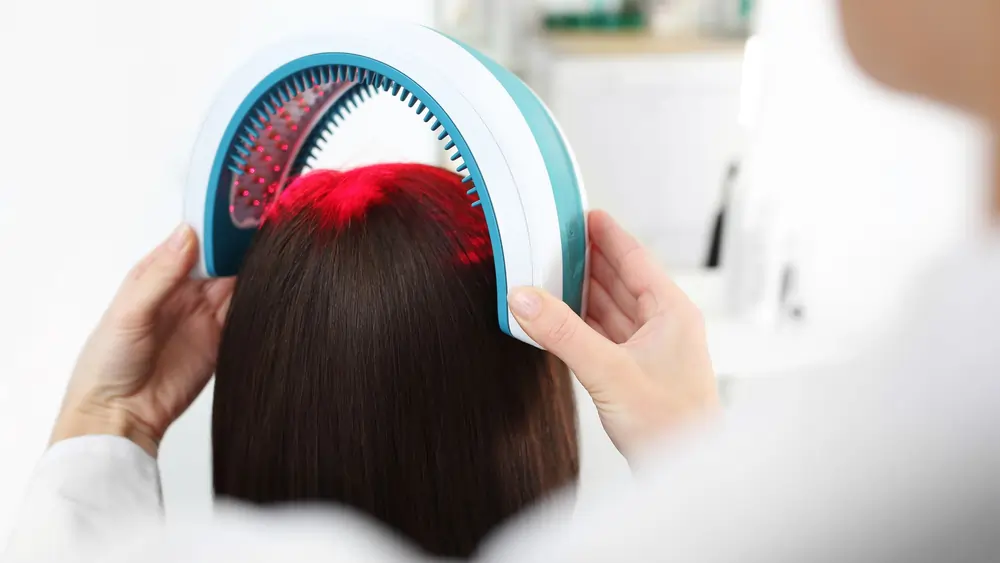Ever wondered about the phenomenon of shock loss after a hair transplant and how it might affect your quest for a fuller head of hair? Picture this: You’ve taken the bold step to undergo a transformative hair transplant, envisioning a lush, natural mane that boosts your confidence. However, in the aftermath of the procedure, a lingering concern clouds your excitement – the possibility of hair loss, not gain. If you’ve found yourself pondering the uncertainties of shock loss you’re not alone. Let’s unravel the mystery and navigate through the common worries that accompany it.
What is Shock Loss?
Shock loss, scientifically known as telogen effluvium, is a temporary but disconcerting side effect of hair transplant procedures. In simple terms, it refers to the shedding of existing hair in the recipient area, the region where new hair follicles are transplanted. This shedding can occur in the weeks or months following the surgery, leaving individuals understandably anxious about the success of their transplant.
Understanding and addressing shock loss after a hair transplant is not just an academic exercise but a crucial aspect for anyone contemplating or recovering from a hair transplant. So, let’s unravel the layers of hair loss after a hair transplant and shed light on why it’s a passing cloud on the path to a fuller, more vibrant head of hair.
Causes of Shock Loss After a Hair Transplant
- Trauma during Transplant: The very process designed to enhance your hair can paradoxically lead to a phenomenon known as shock loss. During a hair transplant, the surgeon meticulously extracts and implants hair follicles, a procedure that, while skillfully executed, introduces trauma to the scalp. This trauma can trigger the shedding of existing hair in the recipient area, a temporary setback that often raises questions and concerns in the minds of those undergoing the transformation.
- Blood Supply Disruption: Imagine your hair follicles as delicate plants requiring a steady supply of nutrients to flourish. The transplant procedure, albeit minimally invasive, can temporarily disrupt the blood supply to existing hair follicles in the recipient area. This disruption, a consequence of the delicate dance of transplantation, may lead to the phenomenon of shock loss. Understanding this aspect is crucial as it sheds light on the transient nature of the shedding and the body’s intricate healing process.
- Individual Variability: No two individuals are alike, and the same holds true for the experience of shock loss after a hair transplant for men or women. This variability is influenced by a myriad of factors, including genetics and overall health. Some may undergo minimal shedding, while others might experience a more pronounced loss of existing hair. Recognizing this individual variability is key to managing expectations and assuaging concerns as you embark on your unique post-transplant journey. By acknowledging the role of genetics and overall health, we aim to demystify the nuances of shock loss and provide you with a clearer perspective on what to anticipate.
Timeline of Shock Loss
Navigating the journey of a hair transplant involves understanding the temporal aspect of shock loss after a hair transplant. Knowing when to expect changes can alleviate concerns and provide reassurance during the recovery process.
Onset of Shock Loss After a Hair Transplant
The onset of shock loss typically occurs within the initial weeks to months following the hair transplant procedure. It’s not uncommon for individuals to notice increased shedding during this period, which may initially be disconcerting. This phase is a natural part of the healing process and should be viewed as a temporary and expected reaction to the trauma experienced by the scalp during transplantation.
Duration of Shock Loss After a Hair Transplant
While the shedding may be alarming, it’s crucial to recognize that shock loss after a hair transplant is transient. The duration varies among individuals, but in most cases, the shedding is a temporary phase. Hair follicles undergo a natural cycle of growth, rest, and shedding, and the regrowth process may take several months. Patience is key during this period, as the final results of a hair transplant often become more apparent as the healing progresses.
Understanding the timeline of shock loss empowers individuals to anticipate and accept these temporary changes, fostering a positive mindset during the recovery journey. As we delve into the subsequent sections, we’ll explore strategies to manage and minimize the impact of shock loss, allowing you to look forward to the flourishing results of your hair transplant.
Shock Hair Loss: Distinguishing Factors
Understanding the factors that contribute to shock loss is essential for individuals undergoing or considering a hair transplant. By distinguishing between the areas affected and resilient during this process, one can better appreciate the dynamics of this temporary setback.
Recipient Area Impact
Shock loss primarily affects the existing hair in the recipient area—the very region where new hair follicles are transplanted. This shedding might raise concerns, especially for those who anticipated an immediate improvement in overall hair density. However, it’s important to recognize that this shedding is a part of the renewal process. As existing hair sheds, it paves the way for the growth of new, transplanted follicles. In essence, it’s a temporary sacrifice for the long-term gain of a fuller, natural-looking head of hair.
Donor Area Resilience
Conversely, the donor area, from which hair follicles are harvested for transplantation, tends to be more resilient to shock loss after a hair transplant. The follicles in this region are carefully chosen for their robustness, minimizing the risk of shedding. While the donor area may experience some temporary effects, it generally remains less affected than the recipient area.
Recognizing these distinguishing factors offers valuable insights into the dynamics of shock loss. Embracing the understanding that the shedding is a selective and temporary process allows individuals to maintain confidence in the transformative journey of a hair transplant.
Managing Shock Loss After a Hair Transplant
Understanding how to manage and navigate the phase of shock loss is crucial for individuals who have undergone a hair transplant. While the shedding may be a natural part of the healing process, proactive steps can be taken to minimize its impact and promote a smoother recovery.
Patient Reassurance: The first and perhaps most important aspect of managing shock loss after a hair transplant is reassurance. Patients should be informed that experiencing some degree of shedding is a common and expected part of the post-transplant
journey. Reassuring them that this phase is temporary and that regrowth will occur can significantly alleviate anxiety and promote a positive mindset during the recovery process.
Postoperative Care Instructions: Following postoperative care instructions provided by the surgeon is paramount. These guidelines are designed to optimize healing and minimize the risk of complications, including excessive shedding. Patients should adhere to instructions regarding gentle handling of the transplanted area, avoiding activities that may cause trauma, and using recommended products for cleansing and maintenance.
Wait and Watch: Patience is a virtue when it comes to managing shock loss. While it’s natural to be eager for immediate results, the full outcome of a hair transplant takes time. Waiting and watching for the natural regrowth cycle to unfold is essential. In most cases, the shedding is followed by the gradual regrowth of transplanted and existing hair, leading to the desired final results.
By emphasizing patient reassurance, adherence to postoperative care instructions, and a patient’s role in waiting for the regrowth phase, individuals can actively participate in managing and mitigating the impact of shock loss. As we delve further, we’ll explore additional strategies and insights to help individuals navigate this temporary setback on the path to a fuller, more vibrant head of hair.
Preventing or Minimizing Shedding
While shock loss is a natural part of the healing process after a hair transplant, there are strategic steps that both surgeons and patients can take to minimize its occurrence. In this section, we’ll explore proactive measures aimed at preventing or reducing the impact of shedding.
- Surgeon Precautions: Skilled surgeons can play a pivotal role in minimizing trauma during the transplant procedure, thus reducing the likelihood of shock loss. Precise techniques, careful handling of grafts, and minimizing the overall surgical impact on the recipient area are essential aspects of a surgeon’s strategy to mitigate trauma. Patients are encouraged to inquire about the specific measures their surgeon employs to minimize shock loss during the consultation phase.
- Patient Actions: Patients, too, can contribute to the prevention of excessive shedding. Gentle care of the transplanted area postoperatively is paramount. Avoiding activities that may cause trauma, such as excessive scratching or rubbing, can help protect both existing and newly transplanted hair. Patients should diligently follow postoperative care instructions provided by their surgeon, as these guidelines are designed to optimize healing and minimize complications, including shock loss.
- Follow the Surgeon’s Instructions: Post Op care plays a pivotal role in preventing or minimizing shock loss after a hair transplant. Surgeons typically provide detailed instructions on how to care for the transplanted area. This may include guidance on cleansing, the application of prescribed medications, and restrictions on certain activities.
Final Words: Understanding Shock Loss After Hair Transplantation
Shock loss after a hair transplant is a natural and expected phase characterized by the temporary shedding of existing hair in the recipient area. This shedding occurs due to the trauma of the transplant procedure and temporary disruption of blood supply to existing hair follicles.
While the prospect of losing more hair may be disheartening, it’s essential to understand that shedding is a passing phase in the broader journey of hair restoration. Reassurance is a cornerstone during this period, emphasizing that regrowth will follow and lead to the desired results.
Initiating a dialogue about individualized risk factors for shock loss during the consultation with a qualified professional is crucial. This sets the stage for informed decision-making and establishes realistic expectations tailored to each individual’s unique circumstances.
Patience becomes a virtue as individuals navigate the regrowth phase. Waiting and watching for the natural cycle of hair growth, rest, and shedding allows for the emergence of the full, transformative results of a hair transplant.




